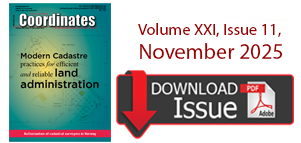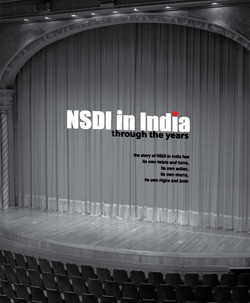Articles in the Articles Category
March 2012,
Munich Satellite Navigation Summmit 2011,
13 – 15 March, munich, Germany,
www.munich-satellite-navigation-summmit.org;

Jarrett’s wines, the subject location of this study, had undertaken much of the above however it soon became apparent that data was poorly managed, with a mix of hard- and soft-copy data. The importance of spatial data management is rarely reported in the PV literature, and the ad hoc nature of spatial data acquisition and surveyor involvement limits the opportunities for an effi cient spatial data management system to be implemented.

The discussions in the United States among LightSquared, the Federal Communications Commission (FCC), the Global Positioning System (GPS) industry, Department of Defence (DoD), Department of Transportation (DoT) and users about the division of spectrum in the L-band should not be seen as just an internal US affair. The strength of both the camps, Telecom providers and the GPS industry indicate that this battle may easily expand to other parts of the world. For many, this battle was a surprise, particularly for a peaceful world like navigation, where discussions are more gentlemen like and either focused on which GNSS systems is the best, or on the backup of GNSS which is so vulnerable and where society cannot function anymore without GNSS. All this changed abruptly when LightSquared published plans to install 40,000 transmitters in a band adjacent to L1 band used by GPS. This led to numerous protests in the GPS industry and among its users as what has been published in many magazines. It is for us to see whether it is telecom versus GPS, or is there a sensible cooperation in reach?

Indeed, the successful launch of two Galileo satellites on 21 October 2011 from French Guyana was a key step for the programme. Galileo is now becoming a reality and I am really proud of it. The EU, with its partners, in particular the European Space Agency, has demonstrated its ability to manage such a large scale programme. We are reaping the fruits of our continuous efforts. The programme is under control both on programmatic and fi nancial levels and it is now possible to accelerate the deployment of the constellation of satellites. That is why I have decided to buy additional satellites.

7 – 8 December 2011, Noida, India
Mr Rajendra S Pawar addressing the conference
The 12th Annual Esri India User Conference was a big hit with Users and Partners from across all spectrums of GIS Users. Held at the Radisson Blu MBD Hotel at Noida on Dec. 7th & 8th, 2011. It was a resounding success for …
January 2012:
ION International Technical Meeting,
30 Jan-1 Feb,California, United States (USA),
http://ion.org/meetings

The bottom line is that the LightSquared signals interfere with GPS, and LightSquared should not be allowed to proceed until the interference problems are resolved. To understand this perspective, some background is useful. The spectrum allocated to GPS for its L1 signal is from 1559 MHz to 1591 MHZ. This spectrum is shared by other Global Navigation Satellite Systems such as the EU’s Galileo, China’s Compass, and shortly also by Russia’s GLONASS, which uses the 1598 MHz to 1605 MHz band for its present signals. Basically, GNSS signals occupy the 1559 MHz – 1605 MHz band.

Precision viticulture (PV) is styled from the zonal management paradigm of precision agriculture, where large homogeneous fields are divided into smaller units based on yield or other field characteristics which may be differentially managed (Lamb et al., 2002, Bramley, 2009, Bramley and Robert, 2003) (Note that McBratney et al. (2005) suggest the definition of precision agriculture is continually evolving as we develop further technologies and greater awareness of agricultural processes). PV acknowledges the numerous spatial variations that affect grape quality and yield, including soil characteristics, pests and diseases and topography (Hall et al., 2003, Arnó et al., 2009), providing land managers with the tools to quantify and manage this variability (Proffitt, 2006). Land managers can thus ‘selectively’ treat areas, for example by the variable application of mulch, water, fertiliser, sprays etc.












 (5.00 out of 5)
(5.00 out of 5)